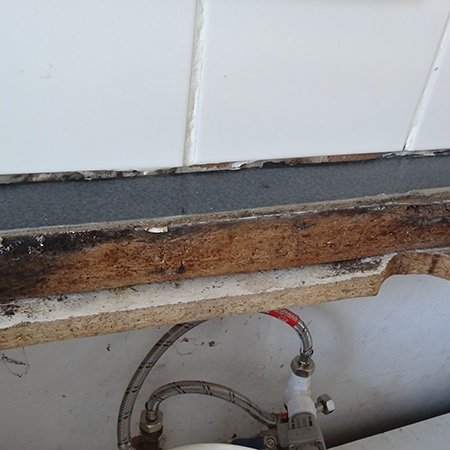We've stumbled on this great article on How To Prevent Water Damage To Your Kitchen below on the web and decided it made good sense to write about it with you over here.

The cooking area is the space where a great deal of water activity goes on. You can hardly do anything without using water in the kitchen, from food preparation, cleansing, as well as doing the meals.
Therefore, checking your kitchen every now and then is a necessity. This is because it has a greater opportunity of getting water damage because of the appliances you make use of there.
When malfunctioning, these home appliances that control water can make your cooking area untidy and affect the framework of your building in the long run.
Let's examine out some causes of the water damage in the kitchen and also what you ought to look out for.
Some Causes of Water Problems in the Kitchen area
These are a few sources of water damage in the kitchen area.
Faulty Drain Pipeline
Drain pipes Pipes are necessary parts of our residences, particularly in our shower rooms and cooking areas. They obtain malfunctioning by getting obstructed, split, as well as ruptured. Or even worse, they can be wrongly or freely linked; whichever the instance might be, it can be a severe trouble.
Defective drainpipe pipelines can cause water damage as well as, consequently, create mold development as well as injure the appearance of your wall. It can likewise make the affected location look messy.
Consequently, it is recommended constantly to check to make certain that all the pipes remain in good condition and obtain a sound pipes system to maintain as well as fix any type of issues.
Faulty Kitchen Sink
The kitchen area sink is an essential and a lot of used part of the kitchen area. Therefore it is prone to water damage; damages such as obstructed pipelines, leaky pipelines, and also faulty faucets.
These problems can be bothersome, particularly when one is active in the cooking area. It doesn't simply take place without offering an indicator or a clue. Below are some indicators to recognize when your sink is not okay
These are the significant damages that can happen to your kitchen sink. Nonetheless, one method to stop this damage is by making sure that food bits do not get into the pipelines. You are likewise checking the pipelines as well as faucets and making certain that it is appropriately repaired and also in good condition.
Dripping Dishwasher
Dishwashers make life in the cooking area simpler. Nonetheless, it is an optional kitchen area appliance and also, when offered, can be a source of water damage. On top of that, like various other machines, it will certainly develop mistakes in time, even with upkeep.
One of the mistakes is leaking via the door or beneath the dish washer. These faults create because of age, splits, wrong use, loose web links to pipes, and so on.
Faults as a result of age come from continual usage. Therefore, the door leaks as a result of shutting and also opening.
Mistakes from the wrong use may create water damage by introducing splits to it. It is advisable to comply with the manual guide of the dish washer to prevent this certain damage.
The leaks under the dish washer can come from splits in the gasket, hose, as well as loosened or wrong connection to pipes or drains pipes.
This kind of leakage often goes unnoticed and also can be there for a long time. Nevertheless, as a result of the time framework, it can damage the floor and also cause mold development.
A lot more so, the longer the water remains, you will discover the bending of the flooring where the dish washer is. This is a good indication to keep an eye out for when examining if your dishwasher leaks. Finding as well as repairing this promptly prevents major water damage to your flooring.
Profits
Keeping an eye out for problems in your cooking area can be tasking but required. It makes your work there much easier as well as much safer.
Nonetheless, the reasons detailed above are just a couple of factors to take into consideration, specifically if your cooking area has a great deal of devices.
Obtain an expert plumbing service to come about and also inspect for any type of damage and obtain them taken care of.
It makes your kitchen area wet and unpleasant, especially when trickling from the pipelines. As well as if it is dripping from the tap, it leads to water wastefulness.
It is an optional kitchen area appliance and, when readily available, can be a source of water damage. Much more so, the longer the water remains, you will certainly discover the warping of the flooring where the dishwashing machine is. Finding and repairing this on time avoids serious water damage to your floor covering.
WAYS TO PROTECT YOUR KITCHEN FROM WATER DAMAGE
The kitchen is one of the most significant rooms in your house, as it is a multipurpose room wherein you can do your cooking and cleaning. Nowadays, homeowners tend to ignore the problems under their sink or appliances because of their busy schedules. However, most household floods occur due to plumbing and appliance failure. One of the most common scenarios that cause water damage to your kitchen is when the dishwasher malfunctions and floods gallons of water.
Water damage in your kitchen can cause several problems, including cosmetic damage, mold growth, and even an unpleasant smell. Often, if you fail to neglect the problem, there are always consequences. This article will help you protect your kitchen from water damage.
Common Causes of Water damage in your kitchen
Pipe problems are the most common source of water leaks under your sink. If homeowners ignore this issue, it will burst and flood the kitchen. Dishwasher leaks can be a source of water damage in your kitchen. An old, broken, and defective dishwasher can cause leaks, damage to your floor, and even mold growth. Refrigerator leaks can cause water damage in your kitchen, as sometimes melted ice from defrosting can cause leaks. Furthermore, if your refrigerator has internal problems, it is very likely to cause water damage. Back-splash and sink caulking can cause discoloration and water damage to your countertop tiles. Ways to Protect Your Kitchen From Water Damage
Regular maintenance
The most important thing you can do to protect your kitchen from water damage is to inspect the sinks, drains, and pipes, as well as the kitchen appliances, regularly. As with the sink, check for missing or deteriorated caulk. Remove the old caulk and clean the area thoroughly and re-seal it with fresh silicone. Furthermore, sweep the drain regularly, empty the filter and dispose of the debris in the garbage, and inspect the supply lines and valve for cracks.
Check your appliances
Check the user’s manual for instruction and proper use of every water-related appliance installed in your kitchen. For the dishwasher, check this procedure to prevent the dishwasher from flooding your kitchen. Check the appliances that need water, such as the coffee maker, ice maker, and water cooler, as they can become the cause of water damage in your kitchen. You may call a professional to check and repair damaged appliances and professional restoration for water damage clean-up.
Garbage clean-up
Fats, oil, and grease are common in the kitchen. Pouring them down the drain can cause clogs and sewage backup, which may result in significant kitchen water damage. If your kitchen sink is clogged, use a solution of hot water, baking soda, and vinegar to unclog the fats and oils in the pipes. Also, make sure to throw out the debris in the trash and clean the sink properly using paper towels for greases and oil and soap or bleach solution for the sink itself.
Shut off your water line
Make sure to shut off your main water line, especially if you're away and having some flood issue. As mentioned, dishwasher leaks are one of the most common culprits of water damage in the kitchen. So, make sure to only use the dishwasher if someone is at home and available to attend in case a problem arises.
Furthermore, it is also important that every member of your household knows where the shut-off valves are located. So in case of an emergency, they can mitigate the damage by turning off the water source.
Install leak detectors
One of the best ways to catch water damage before it could even cause serious damage to your home or business is by installing a water or leak detector. A leak detector monitors the flow of water through a pipeline, can detect moisture in the air for molds, and tracks the water temperature. Also, it can shut off your water line in case of an emergency. Install leak detectors under the kitchen sink, near the dishwasher and refrigerator.
https://superiorrestore.com/7-ways-to-protect-your-kitchen-from-water-damage/

I'm very focused on How To Prevent Water Damage To Your Kitchen and I really hope you appreciated the entry. Are you aware of somebody else who is fascinated with the topic? Do not hesitate to share it. Thank-you for going through it.
Visit My Website
 Marques Houston Then & Now!
Marques Houston Then & Now! Sam Woods Then & Now!
Sam Woods Then & Now! Bo Derek Then & Now!
Bo Derek Then & Now! The Olsen Twins Then & Now!
The Olsen Twins Then & Now! Sarah Michelle Gellar Then & Now!
Sarah Michelle Gellar Then & Now!